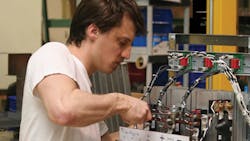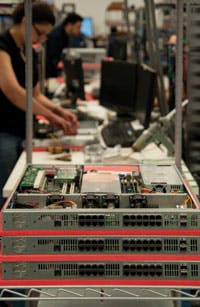What is HindlePower Inc.'s greatest selling tool? That's the wrong question to ask of this Easton, Pa., manufacturing company because its greatest selling tool is not a what, it's a who.
The right answer, says the president of this 80-person manufacturer of constant voltage float battery chargers, is the plant-floor workforce. They are the individuals responsible for presenting plant tours to potential customers, answering their questions and delivering the requested information. President Bill Hindle says they never fail.
"We haven't missed. It sells 100% of the time," he says.
Hindle -- or any manager -- is not involved in the plant tours. The company president shares with visitors the company's operational guidelines, shows them where the production lines are and advises of any safety considerations, and then sends them to the floor.
"I ask visitors to please ask any employee any question you want," Hindle says. "They come back shaking their heads, and when they leave, we get the orders. Afterward, they say, 'I cannot believe the level of trust that your organization has with its employees. If that level of trust exists, I want my products coming out of that plant.' Sold. How's that for an unexpected value of labor?"
See Also: Building Blocks to Corporate Culture
For Hindle, the value of labor is easy to quantify. His company has grown by 12% to 14% a year for the past 10 years, enviable numbers at any time but also noteworthy because the company's upward trajectory continued even as the Great Recession knocked back U.S. manufacturers left and right during the past few years.
Again, he pinpoints exactly why his firm has done so well.
"If you really want a great company, it's all about the people, only about the people," he says. "Take care of all their needs, and they'll make sure the job is done."
Not all leaders share Hindle's ease in recognizing -- and measuring -- labor's value. And capturing a definition of the value of labor proves more troublesome than defining either the cost of labor -- which in many instances is a line item on the budget and includes salaries, wages and benefits -- or labor productivity.
"It's not that the value of labor is ignored, it's that it is not thought about in many organizations," suggests Rick Bohan, principal of Chagrin River Consulting. He hasn't observed many smaller organizations that have looked at labor from a strategic viewpoint. "They aren't asking, 'What advantage does labor give us strategically, or what could it be giving us and how do we hire to get that value? How do we train to get that value? How do we motivate and compensate to maximize that value?'"
While such questions typically arise in the context of cutting labor, they are equally important when business is growing, Bohan says. "When revenue and demand increase, there is a tendency to say, 'Just get people in here, and we'll figure out what to do with them.' If there is not a value of labor [consideration], the organization will end up with a lot of turnover, lowered productivity for long periods of time, higher levels of scrap and lower efficiencies due to more delays."
Organizations that consider the value of labor are unlikely to make hiring decisions based only on increasing capacity at the lowest possible cost. "The strategic advantage isn't going to come just from employees operating a piece of equipment," says Bohan. "The strategic advantage is going to come from their creativity, their productivity and their helping to improve processes."
See Also: Lean Manufacturing Leadership Best Practices
MBX Systems aims to capture that strategic advantage. "One of the greatest values that any one person brings to the team is their potential," says Carl Nothnagel, director of operations at MBX Systems, a manufacturer of server appliances and embedded systems.
"Sometimes this potential is clear and measureable. For example, this person can do the job of two of his peers when under pressure," he says.
"I find the value is often more on the immeasurable side," he adds. "These often manifest themselves in ideas or creative solutions to 'everyday problems.' Once an idea has come to fruition, it can then be measured as value."
As an example, MBX Systems has implemented a lean-oriented campaign to solicit improvement ideas. A new workstation format that increases throughput emerged from that program.
Pella, Iowa-based Vermeer Corp. has long shared a similar perspective. The company, which manufactures agricultural, construction and other industrial equipment, is 16 years into its lean journey and continues to rely on people-driven process improvements to deliver a competitive edge.
"We are only going to be as good as the process improvements, the productivity improvements that we do each year in order to stay competitive. That all starts with people," says Doug Hundt, president of Vermeer's underground and specialty excavation segments. "When you are truly implementing lean in a fundamental way, our people are the ones determining where we can improve, how we can improve."
He also notes the danger of viewing labor solely as a cost, citing the high cost of hiring and poor quality that may result when turnover is high and employee retention is low.
Highly Valued at HindlePower
HindlePower has no time clocks or attendance policies that track the comings and goings of its employees. If an office worker -- or a plant worker -- needs to pick up a child from school or leave work to take a family member to the orthodontist, that employee just gets up and goes.
"Family comes first," says Hindle. "That is standard."
It is a standard that works well for HindlePower. "Employees make up their [missed] time," says the company president. "For 45 people out in the plant, we hit between 97% and 100% of 40 hours every week, every month, every year. We don't think about attendance anymore."
How does it happen? "They are important to the success of the organization and I tell them, 'If we didn't need you 40 hours a week we wouldn't have hired you. But we did hire you and we need you 40 hours a week. So you have an obligation not only to the company but to your peers alongside of you,'" Hindle explains. "People come to work."
Hindle's perspective of the value of labor also serves the company well in avoiding the skilled-worker shortage plaguing many manufacturers. That may be due to his belief that a wealth of promising people are available.
"You have to create an environment that allows them to grow. You've got to be willing to educate people," he says. "The criticism you're hearing is like the 90-second hamburger. They want to hire a person and want them to be productive instantly. It's never going to happen. I maintain there are very good people to be had, you just have to be more patient."
The Professional Manufacturing Team
HindlePower introduced a new initiative earlier this year, one the president calls the Professional Manufacturing Team. It's yet another evolution of the company's culture and one Hindle says is aimed at further tapping the potential of the plant-floor workforce.
The initiative includes training, plant-floor ownership of the company's lean efforts, job certification and other components. "This thing took off like wildfire," he says. One example is the rebuilding of a production line that grew production from 350,000 units a week to 500,000 a week. In another example, Hindle points to an email he received from a plant-floor safety committee member.
The email signature included her name and the words "professional manufacturer." "That's how she views herself now. And they are professionals," he says.
Hindle admits he has a tendency to get on a soapbox on the topic of workforce and corporate culture -- but only because he speaks the truth. "The value in labor is far, far greater than any CEO believes or can ever imagine," he says. "Give them the right environment, and it is incredible what they can do for your organization."
About the Author
Jill Jusko
Bio: Jill Jusko is executive editor for IndustryWeek. She has been writing about manufacturing operations leadership for more than 20 years. Her coverage spotlights companies that are in pursuit of world-class results in quality, productivity, cost and other benchmarks by implementing the latest continuous improvement and lean/Six-Sigma strategies. Jill also coordinates IndustryWeek’s Best Plants Awards Program, which annually salutes the leading manufacturing facilities in North America.
Have a story idea? Send it to [email protected].



